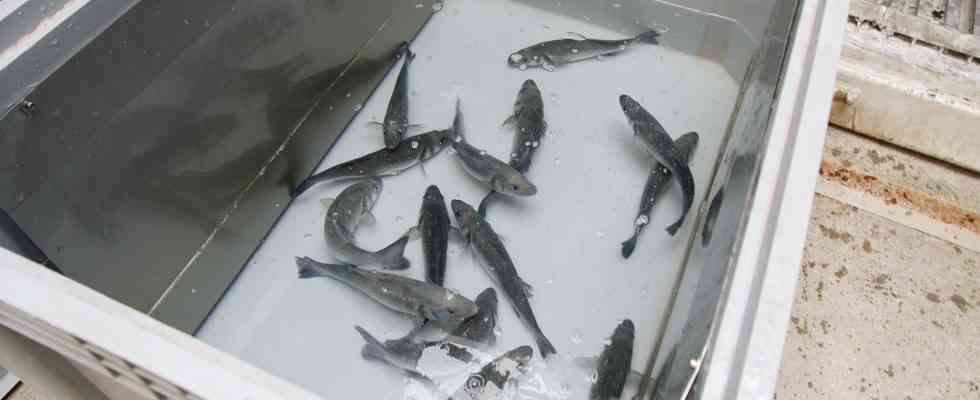In the middle
Status: 09.03.2023 11:47 a.m
Cold chain, transport routes, overfishing: Anyone who buys sea fish in the supermarket often does so with a bad conscience. A start-up from Saarland wants to solve the problem – with innovative fish farming systems.
Today there are eight fish that Hauke Peters catches. Sea bass, the Mediterranean fish par excellence. But Peters is not a fisherman and is not standing on a fishing boat. He has dry ground under his feet – in a container in an industrial park in Saarbrücken, 600 kilometers from the Mediterranean Sea.
Peters is a scientist and does research around a pool with 70,000 liters of salt water. A company from Saarland developed and built the fish farm. It fits in four freight containers and costs around half a million euros. The idea is simple: if the fish grows where it is needed, there are no long transport routes from the sea to the customer. Farmers could build up a second mainstay, and catering establishments could provide their guests with freshly caught fish.
The container in which Hauke Peters fishes is the prototype. So that potential customers can see how the concept works. Only three have been sold, but there is interest, says founder Carolin Ackermann: “People have the desire and the power to put something on the road. They want to implement sustainable projects in order to make their contribution.”
Hauke Peters nets sea bass from a basin.
Image: Florian Decker
The operation runs mostly automatically
It took a long time before container fish farming produced the first fillets: As students, the founders researched the large sea fish farm in Völklingen, less than fifteen minutes from Saarbrücken. They wrote such high losses with state funds that the state parliament set up a committee of inquiry. But the principle of breeding marine fish without access to the sea had potential. The students became entrepreneurs and the “Seawater Cube” was born.
“There is a rethinking around the world, slowly but surely,” says Fabian Schäfer from the Leibniz Institute for Freshwater Ecology and Inland Fisheries in Berlin. “It makes sense to scale down fish farming. In this way, lateral entrants can also get involved and unused areas can be used sensibly. But compared to low-tech systems such as classic aquaculture in the sea, this is an enormous additional effort.”
The “Seawater Cubes” team relies on high-tech. In this way, the company wants to make the system attractive for companies that have no experience with fishing. The feeding, water exchange and heating of the tanks are automatically based on how many fish are in the water and how big they are.
“The customer only has to invest a relatively small amount of time in operating the system,” explains co-founder Christian Steinbach. “And, of course, operational reliability increases. Anything that you don’t have to worry about leads to production running more stably.” He calculates that around an hour a day is enough. For cleaning, refilling food and of course for fishing.
#right in the middle from Saarbrücken: sea fish from the basin
Florian Decker, SR, daily topics 10:15 p.m., March 8, 2023
Farmers are not averse
You can harvest seven tons a year from the container. A large, industrial sea fish farm creates a hundredfold. But it’s still enough to supply a small town with sea fish. And so the farmers – a main target group of the start-up – are not averse either. But for many farmers, the calculation is not yet correct. There are no proven distribution channels for the fish, and without them the investment is too risky. In addition, indoor fish farming does not yet count as agriculture – and therefore does not benefit from the tax breaks that benefit agriculture.
Sea bass and sea bream are currently swimming in the demonstration container in Saarbrücken, but theoretically you can breed almost any sea fish in the “Cube”, as long as it doesn’t get too big. At 500 grams it’s over, otherwise the pool will be too small. The system is therefore not suitable for salmon that weigh several kilos when slaughtered.
In the future, Hauke Peters, the research assistant, also wants to test the Red Drummer. He usually lives off the east coast of the USA and in the Pacific. The chances of finding it at the fish counter in the supermarket are currently zero. If Peters’ test is successful, future fish farming containers could also house this species.
The “Seawater Cubes” team relies on high-tech.
Image: Florian Decker
Waste water and energy must also be sustainable
A fifth container could soon be added. Plants would then grow in it. “We already have a shortage of fertilizers anyway, i.e. nitrogen and phosphates. And what is dissolved in the water here, through the excretions of the fish, are nitrogen and phosphate. So the conclusion is that you combine both and the plants used as a filter,” says Christian Steinbach. But the concept is not yet fully developed, because the ideal plant is still missing. It must be salt water resistant and as versatile as possible.
“You have to watch out for something like this when a fish farm is built on a green field,” agrees Fabian Schäfer from the Leibniz Institute. Basically, he gave the concept of “fish farming in containers” a positive rating. “What happens to the waste water? How energy self-sufficient is the system? Where does the feed come from?” Schäfer also asks. Only if these aspects are also sustainable can the entire system operate sustainably.
Incidentally, the sea bass from the sample container ends up at various restaurants in Saarland. People are excited there. “It’s the best fish I’ve ever had,” says Jenifer Weichel from the “Casino am Staden” restaurant in Saarbrücken. Recently guests have complained. That’s not sea bass. They had just never eaten such fresh sea fish.
Sea bass fried made in Saarland: In restaurants one is enthusiastic.
Image: Florian Decker

